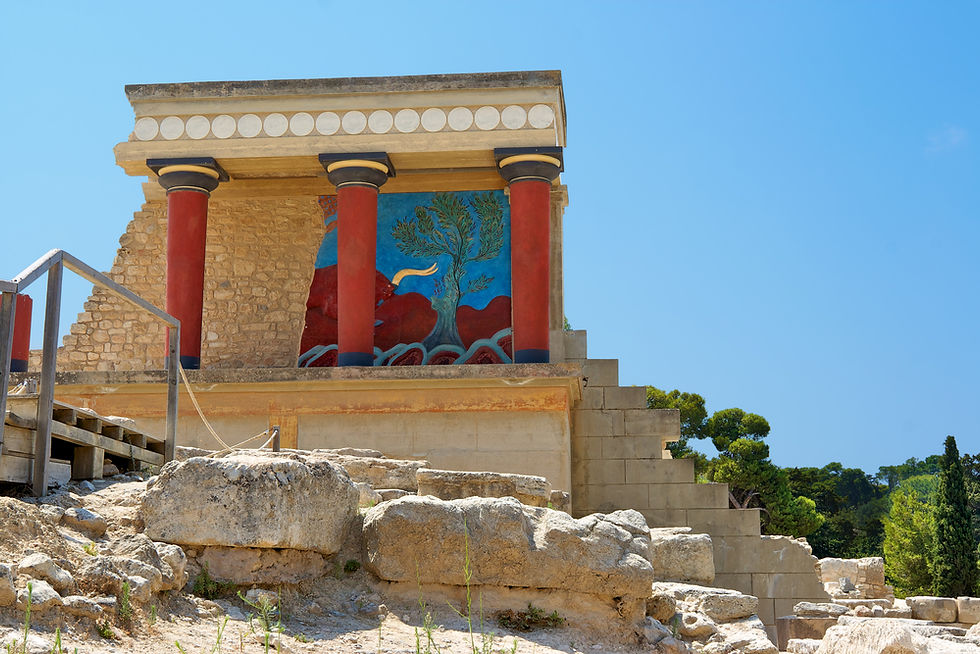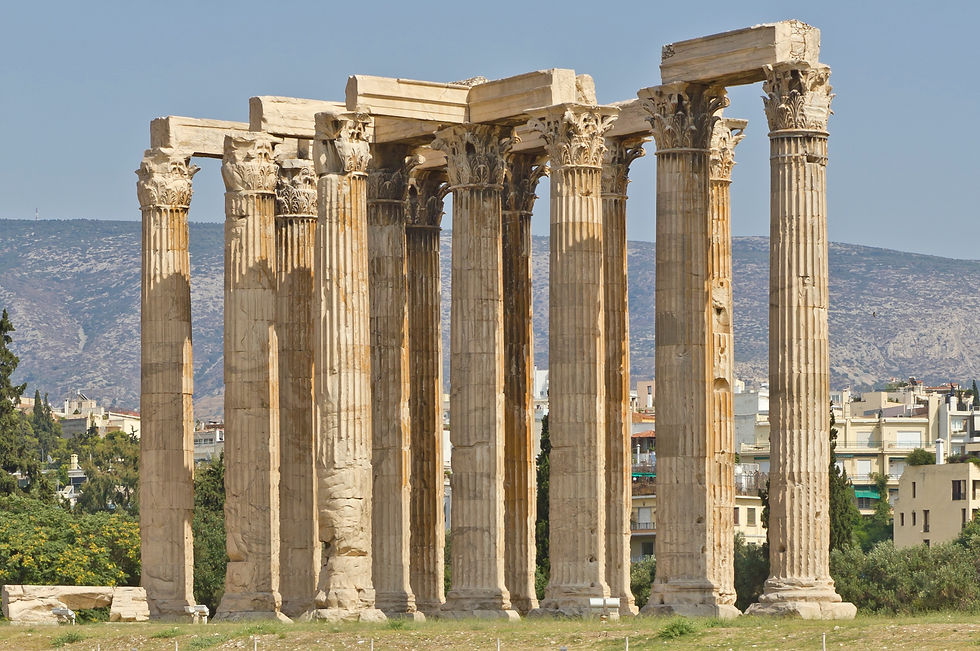From Then to Now - Greek Architecture and its lasting Influence over Time
- maggieyueh
- Nov 25, 2020
- 7 min read
Architecture is everywhere. It is so thoroughly embedded into our natural everyday lives that we often take it for granted, but it also has potential to connect different cultures together and to withstand the changes of time. Ancient Greek architecture is a prime example of this, and upon thinking about the topic of Grecian architecture, their distinctive ancient temples would often come to mind. Their methods and ideals when it comes to architecture have gone on to influence future civilizations, through architectural eras such as the Romans, the Renaissance era, and to the present day. In modern society, Ancient Grecian architecture has now become a symbol of power and knowledge, architecture itself being a temporal anchor to link the past and present cultures together.
But how exactly did their architectural style develop over time to represent power in modern times? Looking into their historical purpose and the different aspects to their architectural style can give insight and understanding into how they’ve become relevant to modern times, and why architecture is now used to create this idea of power, knowledge, democracy, and respect.
Greek Architecture - Their Purpose and Significance
Perhaps the most distinctive type of greek architecture are their temples to deities, which have been developed throughout history in order to attain perfection. Their temples were an integral part of classical society, as it is where they worshipped divinities and served as housing for their statues. In the eighth century BCE, shrines switched from having been originally built out of wood, and were developed into being built out of stone instead. In particular, the sixth century BCE was when Greek city states started competing to outdo each other in various aspects of their society, including architecture. The Acropolis is an example of such rivalry, built in the 5th century BCE in Athens to surpass their rival city states in terms of which city is able to pay a better tribute to their gods.

Ancient Greek architecture is also significant to their mythology, as temples and palaces make appearances inside of their stories. For example, in 1900 BCE, the palace of Minos became the earliest large multiroom complex with a central courtyard. The palace was built in Knossos, and is mentioned alongside King Minos in several myths. It is the primary setting of the Minotaur myth, and appears in other mythical primary sources too, such as Homer’s Odyssey, where it is mentioned that “Among their cities is the great city of Cnosus, where Minos reigned when nine years old, he that held converse with great Zeus”. From early on, this architectural form is used in mythology, and to ground their beliefs to reality whilst paying homage to the gods.

Their architecture is also proof of their integrity and serves as proof of the progression Greek Architects made over time. Adding logic and order to the original plans of Mycenaean palace megarons developed their temples into the iconic buildings remembered to this day.
Architectural Features and Ideals
Greek Architecture has two predominant features that are distinctive of their ideals. At the heart of Greek architecture lies their devotion to logic and order, involving use of mathematics to plan symmetry and structure. Their precision ensured that each building was created with the same dedication towards their sculptural art in mind, all the while maintaining functional purpose.
The second feature of their architectural style is their colonnade-based aesthetic. Greek temples and their emphasis on columns as a part of their structure have become one of the most memorable aspects of their architecture, despite there being several alternative versions to the ways in which their columns are designed. The Ancient Greeks invented the three official classical “orders”, which are three different column styles that are, objectively speaking: the main features of the legacy of Greek Architecture. The three “orders” are the Ionic, Corinthian, and the Doric order. These three orders have become so influential that they paved the way to create two additional orders, which are the Tuscan order and the Composite order, both of which were inspired and took aspects from the original three rather than being new innovations in architecture. These three classical orders have lasted over the passage of time and have become essential to western architecture, and examples of their influence can still be seen today.
The Ionic Order includes a base at the bottom of the column, with very narrow flutes in the column design. They can mostly be recognized by their highly decorative designs at the very top of their columns, which involves spirals that resemble ram horns. From 480 BCE onwards, their decorations have increased in variety and detail, and one of the most prominent examples of an Ionic temple is the Erechtheion (421-406 BCE).

The Corinthian Order was developed later than the other two orders, as it did not originate from wooden architecture, and thus was developed during the late Classical period, around 400-323 BCE. It is the order that is most widespread and developed from the eras after its time, mostly adapted by the Romans who focused on implementing more detail and ornamental designs. This style of column can still be seen at the Temple of the Olympian Zeus, located in Athens and built around 174 BCE.

Finally, the Doric order, which can objectively be seen as the most memorable of the orders, as well as the foundation in which the other two orders were formed from. It is a simple column that can still be seen today, especially in Washington DC, as it was also a defining feature of the Neoclassical style of architecture, Neoclassical being architecture that referenced classical styles and brought it into the modern era. Neoclassicism utilizes both restrain and order, shown through clarity of form, sober colors, and straight lines - an adherence to the values and techniques of ancient Greek architecture. Despite its simplicity, Doric columns are also heavier and thicker in size and width, which means that they were more commonly used for lower levels of buildings, whilst the slimmer Ionic and Corinthian columns were reserved for upper levels.
The most noteworthy example of ancient Grecian architecture, and of the Doric order, is of course, the Parthenon.
The Parthenon - Design, Legacy, and Modern Parallels
Built around 438 BCE atop the Acropolis in Athens, the Parthenon was a tribute to the Goddess Athena, the patron goddess of Athens who is also the god of wisdom, warfare, and craft, including architecture. Its construction began at the very peak of Athens’s empire’s power in 447 BCE, and is monumental in establishing power and association with the divine. Optical tricks of the eye also were implemented in the design, such as thickening certain areas of the columns so that from a distance, the building maintains its perfect straight shape. Such refinements are often unnoticeable, but the minuscule yet refined elements into its construction made the Parthenon visually significant. The Parthenon is iconic in regards to its mathematical formula, where every aspect of its design is precise and harmonious in terms of ratio, and thus the building is described as the predominant example of “divine proportion”.

In Kappraff and McClain’s article “The System of Proportions of the Parthenon: A Work of Musically Inspired Architecture”, they connect the architectural elements involved in the creation of the Parthenon to music and other crafts. There is geometric algebra in which the sculptors followed in order to achieve such precise results, and the article explains that the temple can be seen as an “architectural and sculptural testament to the goddess, embodying the skills of contemporary Greek mathematics, music, and philosophy as an inspiration for the future” (16). These elements make up how influential and awe-inspiring the Parthenon aspired to be, which leads into how it has been used in Athens to show dominance as a city state in knowledge, the arts, and affiliation with the divine, hence how its features can be deemed a symbol of power. The sophisticated refinements in its design also deem it to be symbolic in regards to appearance, as it stands as a sign of power in the landscape of democratic Athens.
Ancient Greek architecture has gone on to affect many cultures, and its influence can still be seen today, symbolizing power, knowledge, respect, and more. With a building as prominent as the Parthenon, it is no wonder that this icon of power has lasted through time, and is now used as inspiration to further demonstrate power. The main evidence of their modern relevance can be seen in places of great importance, such as the neoclassical styled public architecture dominating Washington DC, or the Oslo Trading Building in Norway, all of which look back to ancient Greek temples for inspiration, particularly the Parthenon. Additionally, their style can also be seen in courthouses or government buildings, showing through their design their position, as they symbolically stand on the foundations of Democratic Athens. In a way, Greek architecture led to a domino effect, as aspects of its architectural legacy has gone on to inspire the Romans, who developed it, and then to modern times, where the Neoclassical style revived and adapted it.

Conclusion
History has a very particular way of reintroducing itself over the ever extending passage of time, and Ancient Greece, with its profoundly influential architecture, is a prime example of how a historical parallel can remain both significant and be understood in a new light today. Greek architecture has become a precursor that led to many staple features that are now prevalent in modern architecture, and still remains in the world today as a symbol of respect and power, due to their initial association with temples, divinity, competition, and mathematical prowess. These iconic buildings such as the Parthenon and their Amphitheatres have become distinctly recognizable as a part of Ancient Greek history and their legacy is carried over through eras and cultures to remain relevant today. Studying their history makes it evident just how influential their architecture was, and allows us to understand their role in present modern society.
Works Cited
Cartwright, Mark. “Greek Architecture.” Ancient History Encyclopedia, Ancient History Encyclopedia, 6 Jan. 2013, www.ancient.eu/Greek_Architecture/.
“Greek Architecture (C.900-27 BCE).” Greek Architecture: History, Characteristics, www.visual-arts-cork.com/architecture/greek.htm.
Homer. “The Odyssey” translated by Richmond Lattimore, Harper Perennial Modern Classics, 2007.
“Introduction to Greek Architecture (Article).” Khan Academy, Khan Academy, www.khanacademy.org/humanities/ancient-art-civilizations/greek-art/beginners-guide-greece/a/introduction-to-greek-architecture.
Kappraff, Jay, and Ernest G. McClain. “The System of Proportions of the Parthenon: A Work of Musically Inspired Architecture.” Music in Art, vol. 30, no. 1/2, 2005, pp. 5–16. JSTOR, www.jstor.org/stable/41818772.
Korres, M. 1994. “The Architecture of the Parthenon.” In The Parthenon and Its Impact in Modern Times, edited by P. Tournikiotis, 55–97. Athens: Melissa Publishing House.


Comments